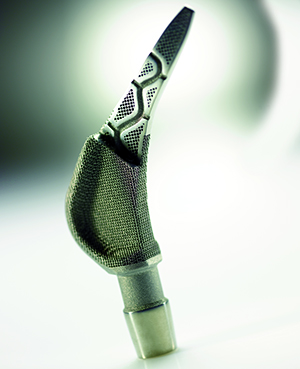3D printing is becoming increasingly popular in the prosthetics and orthotics space. As more clinicians embrace the technology, it promises to transform prosthetic care into a truly patient-centric discipline.

Additive technology provides more flexibility in design — allowing for the production of highly-customizable prostheses, improving fit and enhancing comfort. This helps patients to quickly adapt to their new devices, contributing to a better quality of life. Additive manufacturing (AM) can also cut patient wait times, reduce costs and produce lighter, cooler prostheses.
As a clinician, I have worked with additive technology for nearly a decade. At RAPID + TCT 2023, I'll present a session exploring the benefits of AM for prosthetic and orthotic care. I'll also share a real-world example of the impact that AM-produced prostheses can have on patient lives.
Unlocking Potential
There are two phases to developing a prosthesis. The first is creating a test socket with inexpensive materials to see how a device will fit on a patient. This enables clinicians to iterate on a design before committing to fabrication.
Because 3D printers can work continuously, AM has drastically reduced the effort for production. Today, thanks to technological advances, we can print a test socket for a patient in one or two hours — in theory, while they wait. Sometimes, speed of production is faster than insurance authorization, which is a novel challenge to be addressed.
Once a clinician has perfected the test socket, they can move on to fabrication. Multi jet fusion (MJF), a high-speed powder-based fusion printing technology, is ideal for prostheses because it can manufacture lightweight, durable parts tailored to a patient's specific needs.
When we implemented MJF into our clinical workflow in 2018, one of our earliest experiments was duplicating a traditionally-fabricated socket on the printer. It was an eye-opening experience. Despite having made no adjustments to the design, the patient reported a significant increase in comfort. Others echoed the sentiment.
Since then, we've scaled our efforts, and now, we produce almost every device in our clinic using AM. Thanks to the versatility of MJF, we have also been able to help patients overcome particular challenges with their prostheses.
Racing Forward
In 2020, a clinician approached me. His patient, Richard, had lost his leg below the knee. The patient wanted to get back into marathon running. However, he couldn't train for more than three miles without enduring debilitating pain. The clinician, who had been using traditional production methods, hoped that additive technology might be the solution.
Together, we developed a process to translate the shape of the existing prosthesis into an additively-produced device. Using a custom workflow in Topology, we printed a socket and liner, using features such as variable thickness and lattice spacing to improve the design.
When the clinician fitted the patient, he told us that, for the first time, he didn't have to settle into the prosthesis. He began running again, starting with shorter distances and then tackling 10, 15 and 20-mile runs. Nine months later, he ran a marathon. He was pain and blister free — something he hadn't experienced in years.
The Pace of Adoption
When I began experimenting with digital technology in 2014, it was not widely adopted in the field. Over time, that has shifted. Many companies now employ scanning and fused deposition modeling (FDM) printing for test sockets, although it is rarer to find clinicians using MJF to produce the final socket.
The slower pace of adoption is understandable. As an industry, we exist to serve our patients. Ensuring that the processes we use are safe and effective is essential. That said, AM has the potential to change lives. Events like RAPID + TCT provide a platform to share successes and educate clinicians about the technology and resources available to them.
Richard's case is an example of how the right combination of software, materials and design can revolutionize the patient experience — and the future of healthcare. I look forward to hearing many more stories like his.
 Brent Wright, CP, BOCO, practices at EastPoint Prosthetics and Orthotics in Raleigh, NC. He has been in the field since he started as a technician at age 16 and has seen firsthand how additive technology is evolving and impacts patients not only in the U.S. but also in the developing world.
Brent Wright, CP, BOCO, practices at EastPoint Prosthetics and Orthotics in Raleigh, NC. He has been in the field since he started as a technician at age 16 and has seen firsthand how additive technology is evolving and impacts patients not only in the U.S. but also in the developing world.
While consistently using fused deposition modeling (FDM), Brent is pioneering techniques to effectively use additive technology, such as multi jet fusion and selective laser sintering, to create dynamic prostheses that are light as well as flexible. He is excited that prosthetists have a chance to be a part of the industrial revolution where mass customization and patient outcomes collide.
Brent will lead the workshop How TPU Lattices Structures Enabled a Person with Limb Loss to Run a Marathon on May 2, 2023, at RAPID + TCT 2023.
